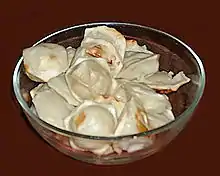 | |
| Type | Dumpling |
|---|---|
| Created by | Ashkenazi Jews |
| Main ingredients | Dough: flour, water and eggs Filling: ground meat, mashed potatoes or other |
Kreplach (from Yiddish: קרעפּלעך, romanized: Kreplekh) are small dumplings in Ashkenazi Jewish cuisine filled with ground meat, mashed potatoes or another filling, usually boiled and served in chicken soup, though they may also be served fried.[1] They are similar to Polish pierogi, Polish and Ukrainian uszka, Russian pelmeni, Italian ravioli or tortellini, German Maultaschen, and Chinese jiaozi and wonton. The dough is traditionally made of flour, water and eggs, kneaded and rolled out thin. Some modern-day cooks use frozen dough sheets or wonton wrappers.[2] Ready-made kreplach are also sold in the kosher freezer section of supermarkets.
History
In Ashkenazi Jewish homes, kreplach are traditionally served on Rosh Hashanah, at the pre-fast meal before Yom Kippur, and on Hoshana Rabbah and Simchat Torah.[1][3]
Kreplach with vegetarian or dairy fillings are also eaten on Purim because the hidden nature of the kreplach interior mimics the "hidden" nature of the Purim miracle.[4] In many communities, meat-filled kreplach are served on Purim. A variety with a sweet cheese filling is served as a starter or main dish in dairy meals, specifically on Shavuot. Fried kreplach are also a popular dish on Chanukah because they are fried in oil, which references the oil miracle of Chanukah.[5]
Stuffed pasta may have migrated from Venice to the Ashkenazi Jews in Germany during the 14th century.[6][5]
Name
The Yiddish word קרעפלעך kreplekh is the plural of krepl, a diminutive of krap, which comes from Yiddish's ancestor language Middle High German, where krappe, krapfe meant "a piece of pastry". From the same source come the German Krapfen ("deep-fried pastry") and its East Central German dialectal variant Kräppel, as well the Silesian Krepel ("doughnut").
By folk etymology, the name has been sometimes explained as standing for the initials of three Jewish holidays which are not real holidays; therefore the meat is covered in dough: K for (Eve of Yom) Kippur, R for (Hoshaana) Rabbah, and P for Purim, which together form the word KReP.[7]
Shape
Some cooks use a square of dough that is filled and folded into triangles. Others use rounds of dough resulting in a crescent shape, or two squares of dough.[8]
See also
References
- 1 2 Claudia Roden, The Book of Jewish Food: An Odyssey from Samarkand and Vilna to the Present Day, Penguin Books, 1999, p. 77-78. ISBN 0140466096
- ↑ Quick and Easy Kreplach Recipe Archived 2011-11-30 at the Wayback Machine | MavenMall
- ↑ Prichep, Deena (September 13, 2013). "The Secret To Making It Through A Yom Kippur Fast? Kreplach". NPR.org. Retrieved 2022-02-16.
- ↑ Claudia Roden, p. 32
- 1 2 Tabachnick, Toby (August 30, 2018). "Holiday kreplach can be a family affair". Jewish Chronicle. Retrieved 2022-02-16.
- ↑ Claudia Roden, p. 133-134
- ↑ Kreplach: The parcels packed with history
- ↑ "Recipe: The time of year to get your fill of kreplach". Jewish Journal. 2014-09-17. Retrieved 2021-02-25.